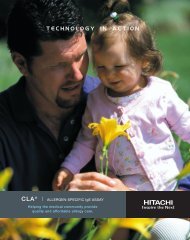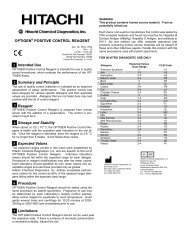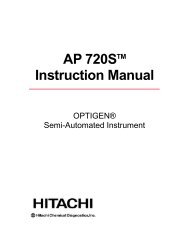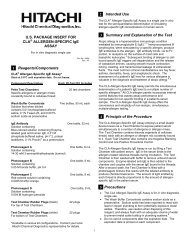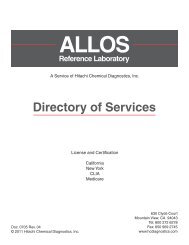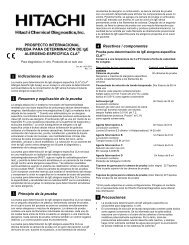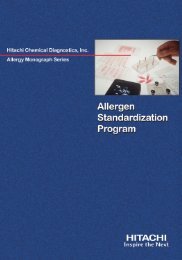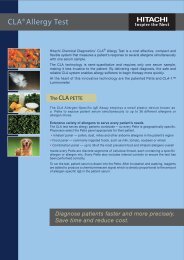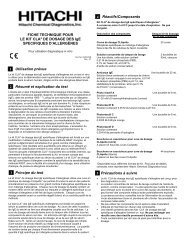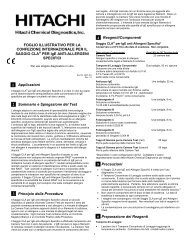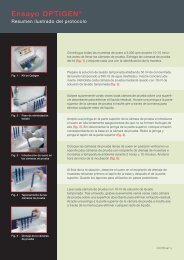Allergen Resource Guide - Hitachi Chemical Diagnostics
Allergen Resource Guide - Hitachi Chemical Diagnostics
Allergen Resource Guide - Hitachi Chemical Diagnostics
Create successful ePaper yourself
Turn your PDF publications into a flip-book with our unique Google optimized e-Paper software.
<strong>Resource</strong> <strong>Guide</strong> to the Most Common <strong>Allergen</strong>s<br />
Common Name: Wheat<br />
Latin Name: Triticum aestivum<br />
NCCLS Code: F4<br />
Description: Allergic reactions to wheat flour may occur by inhalation or ingestion. It<br />
is mostly an environmental allergy observed in bakers. Wheat flour is a<br />
complex mixture of peptide and saccharide-containing substances that<br />
cause an allergic reaction. Major wheat allergens are amylase inhibitors,<br />
which are water-soluble. There is high cross reactivity between wheat<br />
allergenic protein and other grains. Wheat allergens may also show<br />
unspecific cross-reactivity with grass allergens and cause false positive<br />
in vitro test results in grass allergic patients.<br />
<strong>Allergen</strong>ic Proteins (with molecular weight):<br />
Wheat albumins, 69 kDa; Wheat protein, 38 kDa; Glutenin, 26 kDa;<br />
Gliadin, 8-12 kDa<br />
In-House Clinical Evaluation Results:<br />
Sensitivity: 94% Specificity: 100%<br />
Efficiency: 96% Number of Samples: 25<br />
Common Name: Corn (Maize)<br />
Latin Name: Zea mays<br />
NCCLS Code: F8<br />
Description: Corn's major protein is zeins. Zeins are prolamins, a complex group of<br />
alcohol-soluble polypeptides. Major corn proteins include Prolamin and<br />
Polypeptides initiated at a relatively late stage of seed development. In<br />
several mutations of maize, the rate of zein deposition has been altered.<br />
Grain cereals from the Poacea family (corn, rice, wheat, Japanese millet<br />
and Italian millet) appear to be closely related antigenically.<br />
<strong>Allergen</strong>ic Proteins (with molecular weight):<br />
Zea m 14, lipid transfer protein 9 kDa and Zeins, 19 and 21 kDa<br />
In-House Clinical Evaluation Results:<br />
Sensitivity: 80% Specificity: 100%<br />
Efficiency: 87% Number of Samples: 23<br />
Common Name: Rice<br />
Latin Name: Oryza sativa<br />
NCCLS Code: F9<br />
Description: The protein composition of rice grain is 80 percent glutenin, 10 percent<br />
globulins, 5 percent albumins and 5 percent prolamins. Rice protein<br />
belongs to alpha amylase/trypsin inhibitor family. Most rice, including<br />
Japanese rice, contains the allergenic protein. However some Asian<br />
strains contain little or none of the major allergenic protein. The major<br />
rice allergen is an alpha-amylase inhibitor (Ory s 1).<br />
<strong>Allergen</strong>ic Proteins (with molecular weight):<br />
16 kDa<br />
In-House Clinical Evaluation Results:<br />
Sensitivity: 89% Specificity: 100%<br />
Efficiency: 92% Number of Samples: 27<br />
6



